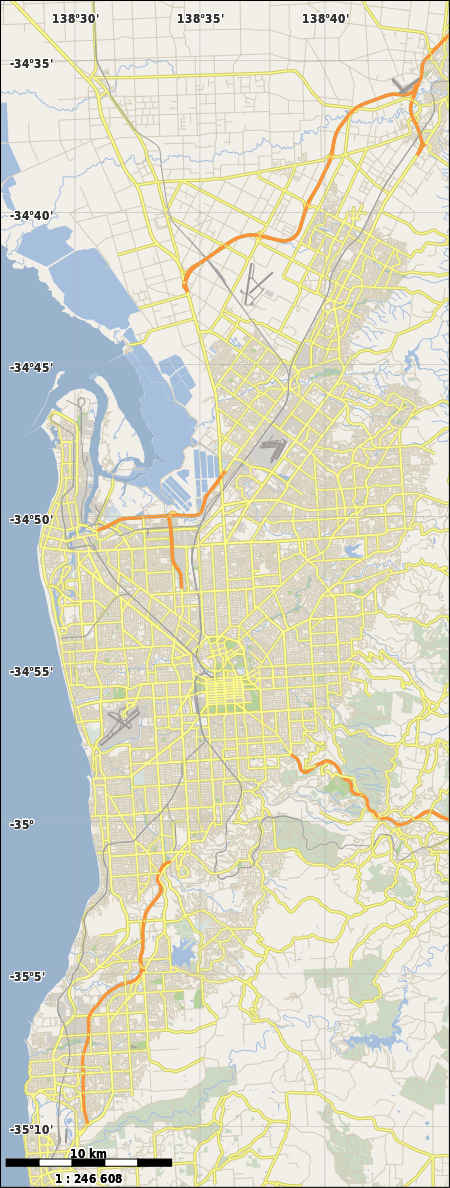South Australian National Football League
The South Australian National Football League, or SANFL (/ˈsænfəl/ or S-A-N-F-L),[1] is an Australian rules football league based in the Australian state of South Australia. It is also the governing body for the sport of Australian rules football in South Australia.
| Current season, competition or edition: | |
 | |
| Formerly | South Australian Football Association (1877–1906) South Australian Football League (1907–1927) |
|---|---|
| Sport | Australian rules football |
| Founded | 30 April 1877 |
| Inaugural season | 1877 |
| CEO | Jake Parkinson |
| No. of teams | 10 |
| Country | Australia |
| Most recent champion(s) | Glenelg (5th premiership) |
| Most titles | Port Adelaide (36 premierships) |
| TV partner(s) | Seven Network Fox Footy |
| Sponsor(s) | Statewide Super |
| Official website | www.sanfl.com.au |
Originally formed as the South Australian Football Association on 30 April 1877, the SANFL is the oldest surviving football league of any code in Australia and one of the oldest football competitions in the world, forming just a few years after the United Hospitals Challenge Cup (1874), the oldest rugby football competition, and over a decade before The Football League, although later than the FA Cup (soccer).
Consisting of a single division competition, since 2014 the season has been an 18-round "home-and-away" (regular) season from April to September. The top five teams play-off in a final series culminating in the grand final for the Thomas Seymour Hill Premiership Trophy. The grand final had traditionally been held at Football Park in October, generally the week after the AFL Grand Final, though this was altered ahead of the 2014 season resulting in Adelaide Oval hosting the grand final in the penultimate weekend of September.
The league owned the sub-licences for South Australia's two AFL clubs – Adelaide Football Club and Port Adelaide Football Club until March 2014, when South Australian Football Commission reached an agreement with the Adelaide and Port Adelaide football clubs – endorsed by the AFL – which will see the two AFL licences transferred to the clubs in return for payments totalling more than $18 million.[2]
The league is also responsible for the management of all levels of football in the state. This includes junior football, country football, amateur football and specific programs rolled out across schools, indigenous communities (including the APY Lands in the state's north) and newly arrived migrant communities.
The SANFL owns Football Park, formerly the largest stadium in South Australia. The stadium, which opened in 1974, was primarily used for Australian Football League matches up until 2013 and had a capacity of over 51,000 prior to being demolished. The stadium was the headquarters for the league from 1974–2013. The SANFL competition is the second highest attended Australian rules football league behind the AFL.
History
Before 1877


The first recorded game of any "football" in South Australia was that of 'Caid' played in Thebarton by people of the local Irish community in 1843 to celebrate St Patrick's Day. In 1844 there was debate amongst the South Australian Legislative Council whether it be allowed that "foot-ball" be played on Sundays, with arguments against preferring the quiet worship of God.[3]In 1859 the Gawler Institute ran a rural fete which included a game of football being staged.[4]
The earliest recorded Australian rules football club in South Australia was Adelaide Football Club (unrelated to the modern day Adelaide Crows), formed in 1860.[5] The early years of football were poorly organised and dogged by argument over which set of rules to adopt. In fact, after a match between Port Adelaide and Kensington in 1873, it was remarked that neither side understood the rules clearly.[6] However, as the years progressed, there became a growing push for uniformity and structure in South Australian football.
1877–1900: League establishment
In 1877, 12 of South Australia's football clubs met to develop a uniform set of rules and establish a governing body. The South Australian Football Association was formed at a meeting at the Prince Alfred Hotel in King William Street, Adelaide[7] on 30 April 1877,[8] the first governing body of its type for football in Australia, and adopted rules similar to those used in Victoria. The inaugural 1877 season was contested by 8 clubs: South Park, Willunga, Port Adelaide, Adelaide, North Adelaide, Gawler, Bankers, Woodville, South Adelaide and Victorian.
| Founding clubs | |||||||
|---|---|---|---|---|---|---|---|
| Adelaide | Bankers | Kensington | Port Adelaide | South Adelaide | South Park | Victorian | Woodville |
Norwood joined the Association the following season in 1878, and went on to win the next six premierships. Norwood, South Adelaide and Port Adelaide together won 23 of the first 24 premierships. South Park, Willunga, North Adelaide, Prince Alfred College, Gawler, Kapunda, Bankers, Woodville, and Victorian all left the Association within the first 10 years. By 1886, the Association had been reduced from 12 to four clubs.
The Association experienced a resurgence in the late 1880s and early 1890s. The addition of North Adelaide (1893), West Adelaide and West Torrens (1897) and only the demise of Adelaide (1893), meant the Association comprised six clubs by the turn of the century. In 1898, the Magarey Medal was awarded to the fairest and most brilliant player for the first time.
In 1899, after a period of declining public interest in football due to the long term inequality between the traditional clubs (Port Adelaide, South Adelaide and Norwood) and the younger clubs (West Adelaide, West Torrens and North Adelaide), the SAFA introduced electorate football, meaning that players were allocated to clubs based on the district in which they resided.[9]
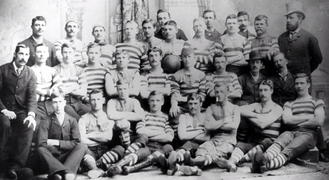 South Adelaide was a strong club in early years winning 8 premierships in the 19th century (1885 South Adelaide team pictured).
South Adelaide was a strong club in early years winning 8 premierships in the 19th century (1885 South Adelaide team pictured). The Norwood Football Club won six premierships in a row from its establishment in 1878 to 1883 (1878 Norwood team pictured).
The Norwood Football Club won six premierships in a row from its establishment in 1878 to 1883 (1878 Norwood team pictured).- Alfred Waldron was an early star.
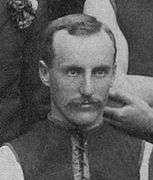 Alby Green won the competition's first Magarey Medal in 1898.
Alby Green won the competition's first Magarey Medal in 1898.
1901–1915: Pre war years
Sturt joined the Association in 1901, but performed poorly initially, finishing last in its first three seasons. In 1902, Port Adelaide adopted its now famous black and white colours. In 1907, the Association changed its name to the South Australian Football League.
Norwood and Port Adelaide continued their domination of the league, and were joined by West Adelaide and North Adelaide; between them, the four clubs won all premierships between 1901 and 1913. West Adelaide followed three straight wooden spoons from 1904–06 with four out of the five premierships from 1908–1912, the most successful period in West Adelaide's history.
The SANFL maintained competition for the first two years of World War I, 1914 and 1915, with Sturt winning their first premiership in 1915, but from 1916 the competition was suspended and did not resume until 1919.
 West Adelaide won four SAFL premierships and two Championships of Australia between 1908 and 1912.
West Adelaide won four SAFL premierships and two Championships of Australia between 1908 and 1912.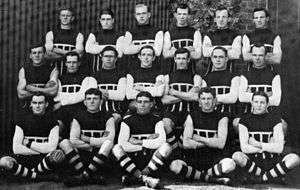 Port Adelaide went through the 1914 SAFL season undefeated.
Port Adelaide went through the 1914 SAFL season undefeated.- Port Adelaide was Champion of Australia 3 times between 1910 and 1914.
1916–1945: Inter war years
Sturt won the first premiership of the post-World War I era, beating North Adelaide in the Challenge Final replay. Glenelg became the newest addition to the league in 1921 and started poorly with five consecutive wooden spoons. In 1927, the South Australian Football League was renamed the South Australian National Football League. Port Adelaide won five premierships in the period 1919–1939, appearing in 12 grand finals.
The SANFL continued normal competition for the first few years of World War II, but from 1942 to 1944 operated on a reduced basis with clubs merged on a geographical basis – Port Adelaide / West Torrens, West Adelaide / Glenelg, Sturt / South Adelaide and Norwood / North Adelaide.
 Pictured above is the 1929 SANFL Grand Final between Port Adelaide and Norwood who by this time had well and truly become the leagues premier rivals.
Pictured above is the 1929 SANFL Grand Final between Port Adelaide and Norwood who by this time had well and truly become the leagues premier rivals.
See Port Adelaide-Norwood SANFL rivalry. Ken Farmer kicked a record 1,417 goals.
Ken Farmer kicked a record 1,417 goals.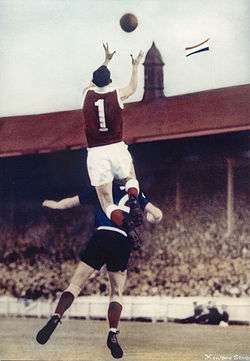 Ian McKay leaps for a spectacular mark in the 1952 SANFL Grand Final
Ian McKay leaps for a spectacular mark in the 1952 SANFL Grand Final
1946–1969: Port Adelaide and Sturt rivalry
Straight after the War Sturt won their Second Premiership. The next three years were dominated by Norwood. Port Adelaide, led by Fos Williams, dominated the 1950s winning seven premierships, including a record setting six Grand Final wins in a row from 1954–59. This record also matched Norwood's six in a row in 1883, set before the advent of regular Grand Finals.
Port Adelaide continued their dominance of the competition in the early 1960s with three more premierships by 1965. In 1964 the SANFL admitted two new clubs, Central District and Woodville. Both clubs performed poorly, and many questioned the purpose of introducing two more teams, in particular Woodville, who were closely surrounded by existing clubs, Port Adelaide and West Torrens. A resurgent Sturt under coach Jack Oatey won five straight premierships from 1966–70, sharing a fierce rivalry with Port Adelaide whom they met in four consecutive Grand Finals.
1970–1979: Golden Era

Sturt began the 1970s by defeating Glenelg in a rain-affected Grand Final by 21 points. North Adelaide secured back-to-back premiership victories over Port Adelaide in 1971 and 1972 and defeated VFL premier Carlton by one point in the end-of-season Championship of Australia match. Port Adelaide continued their success, winning two premierships themselves (1977, 1979), and finishing lower than 3rd only once for the decade. Other premiership winning clubs in the 1970s were Sturt (1970, 1974, 1976), Glenelg (1973), and Norwood (1975, 1978). On 4 May 1974, Central District and North Adelaide played the first game at newly opened Football Park at West Lakes. SANFL moved its administration to the new stadium, and 58,042 attended the first Grand Final at the ground later that year, with Sturt defeating Glenelg by 15 points despite kicking into a stiff breeze in the last quarter after leading by 5 points at three-quarter time. The 1975 season was highlighted by Glenelg's score of 49.23 (317) against Central District, with a winning margin of 238 points which was larger, at that time, than the previous highest score ever recorded by a side in a single game. In 1976, Sturt defeated Grand Final favourites Port Adelaide by 41 points in front of a record ticketed Football Park crowd of 66,897. Norwood won the 1978 premiership in their centenary year by beating Sturt in the Grand Final by one point after Sturt had lost just one game for the entire season. During the 1970s, an increasing number of SANFL players moved to Victoria to play in the VFL competition.
1980–1989: VFL leaves ANFC and expands whilst SANFL struggles
Port Adelaide, Norwood and Glenelg dominated the SANFL in the 1980s, accounting for eight premierships. The exodus of quality players to the VFL continued in the 1980s. In 1981 the VFL rejected a SANFL bid to enter a composite South Australian team to its competition. The SANFL introduced a player retention scheme in 1988 in an attempt to maintain the quality of the competition in the face of falling attendances. Night football was introduced in 1984 after floodlights were installed at Football Park.
1990–1999: Adelaide and Port Adelaide AFL entry

On 31 July 1990, Port Adelaide surprised the SANFL by making an independent bid to join the AFL. The SANFL was left with little option but to submit its own bid to enter the AFL. In a thirty-minute meeting the SANFL formed the Adelaide Football Club. While Port Adelaide had by far the largest supporter base in South Australia, it could not compete with the SANFL's offer of a composite club and the use of Football Park, and in November 1990, following a legal battle, the AFL announced the Adelaide Football Club had been granted a licence and would enter the competition in 1991.
The Adelaide Crows debuted in 1991 wearing the state colours of navy blue, red and yellow. While the Adelaide Crows enjoyed crowds of over 40,000 every week and dominated local media coverage, crowds at local SANFL matches suffered substantially. Port Adelaide dominated the SANFL in this time, winning 7 premierships in the 9 years from 1988 to 1996.
In 1994 after a tender process put to all the SANFL clubs, the Port Adelaide Football Club secured a licence to enter the AFL. Port Adelaide chose the nickname of 'Power' since 'Magpies' was already used by Collingwood. Port Adelaide wished to maintain its presence (as the Magpies) in the SANFL, which was agreed to on the basis that Port Adelaide's SANFL and AFL entities operate independently. The club in the SANFL was renamed "Port Adelaide Magpies Football Club" to reflect this separation.
2000–2009: Central District domination
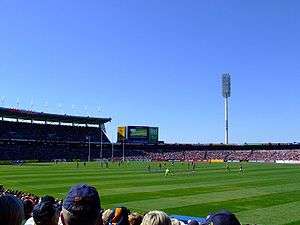
There was a changing of the guard as the new century started. For more than 100 years one of Port Adelaide, Norwood, North Adelaide or Sturt appeared in every Grand Final. The year 2000 saw the two newest teams Central District and Woodville-West Torrens played off in the Grand Final. Central District appeared in every Grand Final from 2000 to 2011, collecting nine premierships (2000-1, 2003–5, 2007–2010). Only Sturt (2002) and Woodville-West Torrens (2006 & 2011) interrupted Centrals' run during this period. Under-age divisions were restructured, with under 17 and under 19 competitions dissolved in favour of under 16 and under 18 leagues, the latter coming into line with Victoria's TAC Cup competition and under the sponsorship of McDonald's would be known as the Macca's Cup. The former would become the Macca's Shield, the season length is around half that of the other levels of competition. Night games would become a feature at Elizabeth Oval, with Central District hosting Saturday night matches from 2006.
2010–present: AFL clubs gain independence and the league returns to Adelaide Oval
Central District appeared in the 2010 & 2011 Grand Finals, with a victory over Norwood for their ninth flag then a loss to Woodville-West Torrens. The 2012 season saw them exit the finals in straight sets after defeats by West Adelaide and then North Adelaide. The 2012 and 2013 premierships were both won by Norwood, firstly defeating West Adelaide by 49 points to win their 28th flag and then subsequently defeating North Adelaide by 40 points for their 29th flag. This was the first time Norwood had won back to back flags for 90 years, when coincidentally they also beat West Adelaide (1922) and North Adelaide (1923).
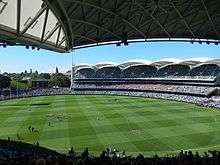
With Norwood and Elizabeth's night match experiment largely successful and popular, West Adelaide (2010), South Adelaide (2011) and Glenelg (2012) would follow suit by installing their own lighting systems at their respective grounds while Woodville-West Torrens had hoped to play under lights at Thebarton Oval, which to date have only done so once in 2012 during their premiership defence.
In 2011, AFL-based Port Adelaide and SANFL-based Port Adelaide Magpies merged to address losses at both clubs, however in 2013 the club announced that the Magpies would officially become the reserves team for Port's AFL players, joining the Adelaide Football Club in fielding a reserves team in the SANFL in time for the 2014 season. These moves caused some furore in some fan circles. The 2013 Grand Final was the last SANFL match at AAMI Stadium, with SANFL league headquarters to remain at AAMI but the finals to return to the new and improved Adelaide Oval from 2014. Ahead of the 2014 season, the AFL-based Adelaide Football Club were granted a licence to field a reserve team in the competition, increasing the number of teams in the league to 10.
As a result of the Magpies becoming the Power's reserve team, and the inclusion of the Crows reserves team in the SANFL in 2014, the other SANFL clubs will lose their AFL contracted players as those contracted to the Crows or Power will move to play exclusively for those clubs in either league. Norwood's dominance of the competition would end in the 2015 season, eliminated at the first week of the finals as West Adelaide ended a 32-year premiership drought with their five-goal defeat of Woodville-West Torrens in the Grand Final.
Clubs
| Club | Nickname | Home ground | Established | First season | Premierships | 2019 | Head coach | |
|---|---|---|---|---|---|---|---|---|
| Adelaide (Reserves) | Crows | None | 1990 | 2014 | 0 | 3 | Heath Younie | |
| Central District | Bulldogs | Elizabeth Oval | 1959 | 1964 | 9 | 8 | Jeff Andrews | |
| Glenelg | Tigers | Glenelg Oval | 1920 | 1921 | 5 | 1 | Mark Stone | |
| North Adelaide | Roosters | Prospect Oval | 1888 | 1888 | 14 | 9 | Jacob Surjan | |
| Norwood | Redlegs | Norwood Oval | 1878 | 1878 | 30 | 4 | Jarrod Cotton | |
| Port Adelaide | Magpies | Alberton Oval | 1870 | 1877 | 36 | 2 | Matthew Lokan | |
| South Adelaide | Panthers | Noarlunga Oval | 1876 | 1877 | 11 | 6 | Jarrad Wright | |
| Sturt | Double Blues | Unley Oval | 1901 | 1901 | 15 | 5 | Nathan Grima | |
| West Adelaide | Bloods | Richmond Oval | 1892 | 1897 | 9 | 10 | Gavin Colville | |
| Woodville-West Torrens | Eagles | Woodville Oval | 1991 | 1991 | 3 | 7 | Sam Lonergan |
*Home grounds are shown using their non-commercial names (note that the Adelaide Football Club, despite being based at Football Park, do not play any home games in the home and away season, except for one Showdown match in a regional South Australian town).
Uniforms
Up to the end of the 2013 season, when not playing with the two Adelaide-based AFL clubs, Port Adelaide Power or the Adelaide Crows, AFL-listed players would play for the SANFL clubs from which they were recruited. Those recruited to these AFL clubs who had not previously played for an SANFL club were allocated to a club by means of a "mini-draft", or played as a "guest player" if they were not playing for their Adelaide based AFL club, and their SANFL club had a bye. AFL club listed players were required to play a minimum of five SANFL games for their club through the season to be eligible to play in the SANFL finals. This rule had been in effect since the Crows first entered the AFL in 1991.
From the 2014 season onwards and on a year-by-year reviewable basis, Adelaide and Port Adelaide will have reserves teams in the SANFL league division. The latter will play as the Magpies and maintain their records and history as Port Adelaide Football Club, with 15 dedicated SANFL players and the rest to be made up of Power-listed players. While the Crows will not take part in the other levels of competition, the SANFL reserves division will see a Magpies team under the banner of an "Academy" team, made up of players aged between 18–22 and any players from that pool of 15 that may be demoted. This season will also be the last that the Magpies are involved at SANFL Under-18's & 16's competitions.
Former clubs
| Club | Nickname | Home ground | Established | Dissolved | Left | First season | Premierships | |
|---|---|---|---|---|---|---|---|---|
| Adelaide (Original) | Adelaide Oval | 1860 | 1893 | n/a | 1877 | 1 | ||
| Bankers | Bankers | 1877 | 1877 | n/a | 1877 | 0 | ||
| Gawler | Albions / Tigers | Gawler Oval | 1868 | n/a | 1890 | 1887 | 0 | |
| Kapunda* | Bombers | Dutton Park | 1866 | n/a | 1878 | 1877* | n/a | |
| Kensington | Kensington Oval | 1871 | 1881 | n/a | 1877 | 0 | ||
| Royal Park | 1880 | 1882 | 1882 | 1882 | 0 | |||
| South Park | 1877 | 1884 | n/a | 1877 | 0 | |||
| Victorian | Bumblebees | Montefiore Oval | 1877 | 1884 | n/a | 1877 | 1 | |
| West Adelaide (1878–1887) | Butchers | 1878 | 1887 | n/a | 1887 | 0 | ||
| West Torrens | Eagles | Thebarton Oval | 1897 | 1991 | n/a | 1897 | 4 | |
| Willunga* | 1874 | n/a | 1885 | 1877* | n/a | |||
| Woodville (1868–1877) | 1868 | 1877 | n/a | 1877 | 0 | |||
| Woodville (1938–1990) | Woodpeckers / Warriors | Woodville Oval | 1938 | 1991 | n/a | 1964 | 0 | |
| *Indicates that the club was an affiliate member who played games against SANFL clubs but did not contest the premiership. | ||||||||
Venues
Games are generally hosted at suburban grounds throughout Adelaide.
| Adelaide | Norwood | ||
|---|---|---|---|
| Adelaide Oval | Norwood Oval | ||
| Capacity: 53,583 | Capacity: 22,000 | ||
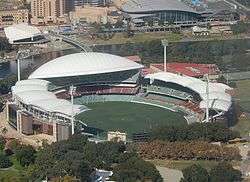 |
 | ||
| Prospect | Elizabeth | ||
| Prospect Oval | Elizabeth Oval | ||
| Capacity: 20,000 | Capacity: 18,000 | ||
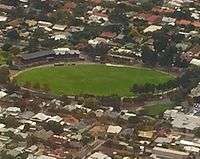 |
 | ||
| Alberton | Richmond | ||
| Alberton Oval | Richmond Oval | ||
| Capacity: 17,000 | Capacity: 16,500 | ||
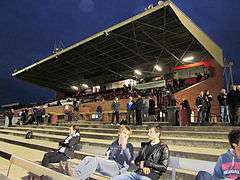 | |||
| Unley | Woodville South | ||
| Unley Oval | Woodville Oval | ||
| Capacity: 15,000 | Capacity: 15,000 | ||
 |
|||
| Glenelg | Noarlunga Downs | ||
| Glenelg Oval | Hickinbotham Oval | ||
| Capacity: 15,000 | 12,000 | ||
|
|
 | ||
Former venues
- Glanville Hall Estate (1870–1879)
- Kensington Oval (1875–1897)
- Jubilee Oval (1898–1906)
- Hindmarsh Oval (1905–1921)
- Thebarton Oval (1922–2012)
- Wayville Showground (1927–1939)
- Football Park (1974–2013)
- Bice Oval (1992–1993)
League administration
The league's revenue is derived from its paid attendance, media and payments from both the Adelaide Crows and Port Adelaide AFL clubs for use of Football Park.
The SANFL is classed as a semi-professional competition. In 2008 the league had a salary cap of $400,000 (excluding service payments).[10] This is the second highest in Australia for an Australian rules football competition, after the AFL.
The Chief Executive Officer (CEO) of the SANFL is Jake Parkinson, who replaced Leigh Wicker in the role in 2014.[11]
SANFL Ladder
South Australian leagues (including the SANFL) award two points for a win, and one for a draw. Elsewhere in Australia generally four points are awarded for a win and two for a draw. In addition, percentage is calculated as "For" ÷ "For and Against" × "100". Elsewhere in Australia it is generally calculated as "For" ÷ "Against" × "100".
Audience
The SANFL match-day program is called the Football Budget and is sold at all SANFL matches. A special edition is produced for the grand final.
The SANFL competition's "match of the round" was broadcast weekly in South Australia on ABC Southern (ABC1 South Australia). Until early 2008, it was also broadcast nationally on ABC2 television. In 2012, nationwide SANFL match replays resumed on ABC2. Match replays are also available nationally on ABC iView. In 2007, the SANFL measured a record 1,415,000 total television viewers.[12]
The SANFL competition is covered by local radio stations Life FM (live) and 5RPH (live). ABC Local Radio and 5AA broadcast the SANFL Finals Series.
In 2013, the SANFL signed a three-year deal with the Seven Network to broadcast weekly matches on 7mate from the start of the 2014 season.[13] Popular Mix102.3 radio host and Seven News Adelaide sports presenter Mark Soderstrom, former Port Adelaide Magpies captain and 5AA breakfast show personality Tim Ginevar, and former Fox Sports commentator John Casey (who spent time with Seven Adelaide during the 1980s and 1990s) will be the chief callers for the 2014 SANFL season. This marks the leagues return to commercial television for the first time since Channel 9 broadcast the SANFL in 1992.
Attendance
Although SANFL crowds now competes heavily with the two AFL national league clubs, the SANFL still has the second highest attendance of any Australian rules football league and the highest attendance for any regional league of any football code. It continues to publish attendance figures.
The record attendance for an SANFL fixture was set at the 1976 SANFL Grand Final between Sturt and Port Adelaide at Football Park which saw 66,987 crammed into the stadium, though some estimate the crowd to have been as high as 80,000 with thousands turned away at the gates.[14] The largest attendance for a minor round fixture was set in Round 19, 1988 for a double header at Football Park. 38,213 fans saw Sturt play Port Adelaide in the early game while reigning premiers North Adelaide faced ladder leaders Central District in the late game.[15] The record suburban ground attendance was an estimated 24,000 who saw Sturt and Norwood at Unley Oval on 9 June 1924.[16] A verified attendance of 22,738 saw Port play Norwood at Alberton in Round 11, 1977*.
* South Adelaide played Port Adelaide in front of 30,618 at the Adelaide Oval in Round 2, 1965. At the time the Adelaide Oval doubled as both league headquarters and South Adelaide's home ground. South Adelaide would move to Hickinbotham Oval in 1995. The Unley Oval record is for current SANFL team home grounds, though the figure was only an estimated amount. Unley Oval's confirmed record attendance of 22,015 was set in Round 9, 1968 for Sturt vs Port Adelaide.
The following are attendance figures since 1991.
| Year | Home & Away | Finals | Games Played | Total | Average | Grand Final | Notes |
|---|---|---|---|---|---|---|---|
| 2018 | 40,355 | ||||||
| 2017 | 39,813 | ||||||
| 2016 | 208,081 | 71,618 | 96 | 279,699 | 2,914 |
30,213 | |
| 2015 | 188,562 | 50,121 | 96 | 238,683 | 2,486 |
25,625 | |
| 2014 | 253,201 | 72,301 | 96 | 325,502 | 3,391 | 38,644 | [17] |
| 2013 | 236,163 | 57,020 | 96 | 293,183 | 3,054 | 36,685 | [18] |
| 2012 | 259,242 | 52,309 | 96 | 311,551 | 3,245 | 29,661 | [19] |
| 2011 | 291,209 | 52,387 | 96 | 343,596 | 3,579 | 25,234 | [20] |
| 2010 | 276,583 | 67,308 | 96 | 343,891 | 3,582 | 34,355 | [21] |
| 2009 | 263,125 | 68,230 | 96 | 331,355 | 3,452 | 35,647 | [22] |
| 2008 | 275,842 | 86,367 | 96 | 362,209 | 3,773 | 34,128 | [23] |
| 2007 | 258,308 | 64,527 | 96 | 322,835 | 3,165 | 30,493 | [24] |
| 2006 | 255,446 | 54,406 | 96 | 309,852 | 3,228 | 25,130 | [25] |
| 2005 | 259,331 | 44,023 | 96 | 303,354 | 2,974 | 28,637 | [26] |
| 2004 | 253,597 | 59,200 | 96 | 312,797 | 3,258 | 24,207 | [27] |
| 2003 | 260,137 | 53,078 | 94 | 313,215 | 3,332 | 28,199 | |
| 2002 | 279,113 | 72,946 | 96 | 352,059 | 3,667 | 35,187 | |
| 2001 | 272,041 | 72,895 | 96 | 344,909 | 3,593 |
26,378 | |
| 2000 | 266,910 | 82,178 | 96 | 349,088 | 3,636 |
34,819 | |
| 1999 | 86,082 | 96 | 39,135 | ||||
| 1998 | 93,910 | 96 | 44,838 | ||||
| 1997 | 96 | 44,161 | |||||
| Port Adelaide enters AFL | |||||||
| 1996 | 96 | 46,210 | |||||
| 1995 | 105 | 45,786 | |||||
| 1994 | 105 | 487,624 | 4,644 |
40,598 | |||
| 1993 | 96 | 446,799 | 4,654 |
42,719 | |||
| 1992 | 105 | 515,299 | 4,908 |
42,242 | |||
| 1991 | 105 | 560,114 | 5,334 |
39,276 | |||
| Adelaide Crows formed | |||||||
| 1990 | 105 | 807,182 | 7,615 | 50,589 | |||
Awards

Club
The Grand Final winners each season are presented the Thomas Seymour Hill Premiership Trophy, named after administrator Thomas Seymour Hill.
The Stanley H. Lewis Memorial Trophy, awarded annually since 1962, recognises the best combined record in all levels of SANFL competition.[28] The trophy is awarded to the best performed club across three grades of the competition – League, Reserves and Under 18, with 100 points allocated for a league win, 50 points for a reserves win and 50 points for an Under 18 win. In the event of a draw, half of the points allocated for a win in that grade are awarded to each club involved.[29]
Individual
The Magarey Medal is awarded to the fairest and most brilliant player in the SANFL each season and is the oldest individual football award in Australia.[30]
The medal was originated by and is named after William Ashley Magarey who, in 1897, was the inaugural chairman of the South Australian Football Association (as the SANFL was then known). In 1898, in an effort to stamp out rough play and improve respect of umpires, Magarey instituted the medal to be awarded to the player deemed by umpires to be the fairest and most brilliant for that season. The inaugural winner of the medal was Norwood's Alby Green. Magarey presented every medal until he died in 1929, with West Adelaide's Robert Snell the last to receive the medal during Magarey's life. The Magarey Medal is still awarded to the fairest and most brilliant SANFL player each season. The Reserves Magarey Medal recognises the standout performers in the seconds or Reserves. It is not unusual for the Reserves Magarey winner to play only half a season in the 'seconds' and the rest of the season in their club's league team.
The Ken Farmer Medal, much like the Coleman Medal in the AFL, is awarded to the league player with the most goals in a season. Named after North Adelaide and South Australia's most prolific goal-kicker Ken Farmer who ended his SANFL career with a still record 1,417 goals, the medal was introduced in 1981 after Farmer's death, with Port Adelaide's Tim Evans winning the inaugural award. Evans kicked 1,019 goals in premiership matches for the Magpies between 1975 and 1986, and is the only player other than Farmer who has kicked over 1,000 goals in the SANFL.
There are also the McCallum and Tomkins Medals, which up until the 2008 season were awarded to the best and fairest players of the U-17 and U-19 divisions respectively. These awards were merged in 2009 when the two under-age competitions were replaced with an U-18's league, similar to those adopted in the West Australian Football League and the VFL's TAC Cup. The first winner of the newly created McCallum-Tomkins Medal was South Adelaide's Luke Bowd.
The Jack Oatey Medal is awarded to the player voted best on ground in the SANFL Grand Final, first awarded in the 1981 premiership decider to Russell Ebert of Port Adelaide. In the same year, the Fos Williams Medal was also commissioned to recognise the standout performer for South Australia in interstate football, the first of which was awarded to Peter Carey of Glenelg.
Despite State of Origin football disappearing from the AFL calendar in 1999, the medal continues to be awarded to the best player for the SANFL representative team in interstate football.
The R.O. Shearman Medal, since its inception in 2000, is awarded to the player voted by the League's senior coaches on a 5–4–3–2–1 basis each game of the home-and-away season.[31]
The Bob Quinn Medal is awarded to the player voted best afield in the Anzac Day matches between the Grand Finalists of the previous year. Commissioned in 2002, the medal was first won by James Gowans of Central District.
Also in 2002, the SANFL created the South Australian Football Hall of Fame to recognise the players, coaches, umpires, administrators and journalists who had made a significant contribution in the SANFL. The inaugural class of 2002 saw 113 inductees into the Hall of Fame and included such greats as Russell Ebert, Ken Farmer, Barrie Robran, Malcolm Blight, Fos Williams, Brian Faehse, Lindsay Head, Neil Kerley, Rick Davies and Jack Oatey.
SANFL Women's
In February 2017, the SANFL followed the example of VFL Women's (Victoria) and created a state-based women's Australian rules football competition replicating its men's league. The SANFLW expanded over the following two years and is now played by eight of the SANFL clubs (Adelaide and Port Adelaide do not feature) from February to May each year. Due to the timing of the league, most SANFLW are not contracted to clubs in the semi-professional AFL Women's national competition. South Adelaide are the current league premiers.
See also
- List of SANFL clubs
- List of SANFL players
- List of SANFL records
- List of Magarey Medallists
- South Australian Football Hall of Fame
- SANFL Grand Finals
- List of SANFL wooden spoons
References
- Rucci, Michelangelo (24 February 2016). "New logo, new brand as SANFL strives to strengthen image in State football". The Advertiser.
- SA FOOTBALL COMMISSION AND AFL AGREE TO TRANSFER OF CROWS AND POWER LICENCES
- "LEGISLATIVE COUNCIL". Southern Australian. VII (549). South Australia. 20 August 1844. p. 2. Retrieved 3 February 2018 – via National Library of Australia.
- "THE GAWLER INSTITUTE RURAL FETE". The South Australian Advertiser. I (208). South Australia. 10 March 1859. p. 3. Retrieved 3 February 2018 – via National Library of Australia.
- "Adelaide (Original)". AustralianFootball.com.
- "Football". South Australian Register. Adelaide: National Library of Australia. 7 July 1873. p. 6. Retrieved 12 March 2013.
- 4 Quarters, Issue No.4, pg 49, September/October 2008, Slattery Media
- Page 5 of 'League Football in South Australia' (circa 1978). Official SANFL publication describing the SANFL's history up to and including its 1977 Centenary season.
- "The Football Difficult". Adelaide Observer. Adelaide, SA. 6 May 1899. p. 19.
- 2007 Salary Cap Changes, media release, FootySA
- SANFL announces new CEO
- 2008 SANFL Match Program announced, 29 November 2007, SANFL website
- SANFL returns to commercial TV in 2014 for first time since 1991 after signing deal with Channel Seven
- "Grand Finals". SANFL. Retrieved 28 July 2011.
- Double Header Blues for Port
- "Spectacular Football". The Advertiser. Adelaide: National Library of Australia. 10 June 1924. p. 12. Retrieved 11 August 2011.
- SANFL 2014 Annual Report
- SANFL 2013 Annual Report
- SANFL 2012 Annual Report
- SANFL 2011 Annual Report
- SANFL 2010 Annual Report
- SANFL 2009 Annual Report
- SANFL 2008 Annual Report
- SANFL 2007 Annual Report
- SANFL 2006 Annual Report
- Main Page, FootySA website
- Thread Page, Big Footy website
- "Stanley H. Lewis Trophy". SANFL. Retrieved 15 September 2014.
- "North Adelaide wins 2014 Stanley H. Lewis Trophy". SANFL. Retrieved 15 September 2014.
- "History of the SANFL".
- Summerton wins 2014 R.O. Shearman Medal as voted by the League's coaches
